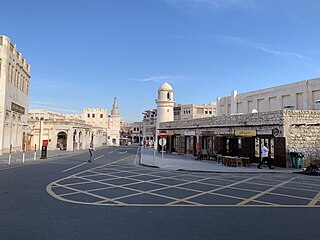
Al Wakrah is the capital city of the Al Wakrah Municipality in Qatar. Al Wakrah's eastern edge touches the shores of the Persian Gulf and Qatar's capital Doha is situated to the city's immediate north. Governed by Sheikh Abdulrahman bin Jassim Al Thani, it was originally a small fishing and pearling village. Over the years, it evolved into a small city with a population of more than 80,000 and is currently one of Qatar's most populous cities.

Abdulla Bin Zaid Al Mahmoud Islamic Cultural Center is a cultural organization in Doha, the capital of Qatar. It is located close to Doha Corniche and is a prominent landmark in the city.

The Museum of Islamic Art (MIA) is a museum on one end of the seven-kilometer-long (4.3 mi) Corniche in Doha, Qatar. As per the architect I. M. Pei's specifications, the museum is built on an island off an artificial projecting peninsula near the traditional dhow harbor. A purpose-built park surrounds the edifice on the eastern and southern facades while two bridges connect the southern front facade of the property with the main peninsula that holds the park. The western and northern facades are marked by the harbor showcasing the Qatari seafaring past. In September 2017, Qatar Museums appointed Julia Gonnella as director of MIA. In 2024 Julia Gonnella became director of the Lusail Museum and was replaced by Shaika Nasser Al-Nassr. In November 2022 the MIA became the first carbon-neutral certified museum in the Middle East Region. The museum participated in the Expo 2023 Doha from October 2023 until March 2024, with workshops and events focusing on biodiversity and sustainability.

Ar-Ruʼays, also spelled Al Ruwais, is a port town in the Qatari municipality of Al Shamal. It is located on the northern tip of Qatar, approximately 127 km (79 mi) north of the capital Doha. Before the country's economic landscape was transformed by oil extraction, Al Ruwais was one of the most important fishing centers on the peninsula.

Al Jasrah is a district in Qatar, located in the municipality of Ad Dawhah.

Al Khor is a coastal city in northeast Qatar, located 50 kilometres (31 mi) north of the capital Doha. Considered one of Qatar's largest cities, it is the capital city of the municipality of Al Khor and Al Thakhira. Dating back to the 18th century, it is one of Qatar's oldest settlements. The name of the city, meaning creek in Arabic, emerged because the original settlement was built on a creek. Until the mid-1900s, it was known as Khor Al Shaqiq.

Al Dafna is a seaside district of the Qatari capital Doha located on the Persian Gulf. The district is rapidly developing into a central business district, and since the late 1990s dozens of skyscrapers have risen in the district, with over fifty more planned. The district is also home to the City Center mall, one of the Middle East's largest malls.

The Doha Corniche is a waterfront promenade and dual carriageway extending for seven kilometres (4.3 mi) along the crescent-shaped Doha Bay in Qatar's capital city, Doha. A lush, semi-circular linear public space, the Corniche serves as the central location for national celebrations, including Qatar National Day Parade and National Sports Day, as well as various religious, civic, and sporting events, making it one of the most popular tourist and recreational destinations in Qatar.

Al Bidda is a neighborhood of Doha, Qatar. It was previously the largest town in Qatar in the 19th century, before Doha, an offshoot of Al Bidda, grew in prominence. Al Bidda was incorporated as a district in the Doha municipality in the late 20th century.

Rumeilah is a neighborhood of Doha, Qatar. It is divided into an eastern and western section. Zone 11, the eastern section, hosts roughly half of Al Bidda Park while Zone 21 contains most of Hamad Medical Corporation's facilities. Hamad Medical City was constructed over 227,000 square meters in Rumeilah at a cost of $659 million. Portions of Hamad Medical City form its own district to the west.

Doha is the capital city and main financial hub of Qatar. Located on the Persian Gulf coast in the east of the country, north of Al Wakrah and south of Al Khor, it is home to most of the country's population. It is also Qatar's fastest growing city, with over 80% of the nation's population living in Doha or its surrounding suburbs, known collectively as the Doha Metropolitan Area.

Qatar Museums is a Qatari government entity that oversees the Museum of Islamic Art (MIA), Mathaf: Arab Museum of Modern Art, MIA Park, QM Gallery at the Katara Cultural Village, ALRIWAQ DOHA Exhibition Space, the Al Zubarah World Heritage Site Visitor Centre, and archaeological projects throughout Qatar, as well as the development of future projects and museums that will highlight its collections across multiple areas of activity including Orientalist art, photography, sports, children's education, and wildlife conservation.

The Qatar Museums (QM) Public Art Department is responsible for overseeing the installation of artwork by renowned artists in the public realm in Qatar, creating an artist residency program for young local artists to help them develop their skills, organizing exhibitions featuring international artists and developing an online community of both local and international creative talents. The QM intends to develop Qatar into a world-class cultural destination, notably in modern and contemporary art.
The following is a timeline of the history of the city of Doha, Qatar.

Qatar National Theater is located on the Doha Corniche, near Al Bidda Park in Doha, Qatar. The 490-seat theatre opened in 1986 and hosts concerts and plays. In addition to hosting local troupes, it also hosts international and Arab theatrical troupes on occasion.

Doha Bay is the semicircular bay bordering Qatar's capital city, Doha. The city was established on the south bank of the bay. Landfill has been used to extend and expand the city to the north around the edge of the bay. Doha Port, Corniche Street and the Doha Corniche, Al Rumaila Park and Sheraton Park border the bay. Palm Tree Island is located in the center of the bay.

Al Najada is a Qatari district in the municipality of Doha. It is one of the oldest districts of Doha. Doha's rapid urbanization during the 1970s after it gained independence resulted in the gradual decline of Al Najada. Several of its historical buildings have been demolished.

Sheikh Faisal Bin Qassim Al Thani Museum is a privately owned museum located in the municipality of Al-Shahaniya in Qatar. Encompassing an area of 530,000 m2, the three-building museum was opened in 1998 by Sheikh Faisal bin Qassim Al Thani.
Doha Port is a census-designated port district in Doha, the capital city of Qatar.
Al Bidda Tower is a 43-storey commercial office building on the Doha Corniche in Al Dafna, Qatar. The building is 215.06 metres (705.6 ft) tall and has 43 floors. Construction begun in 2006 and completed in 2009. The tower includes commercial space, business centres, showrooms, restaurants, art gallery, outdoor café and health club and a 1000 cars parking with direct underground access to the tower.


















